Genkyu-en Garden and Umoregi-no-ya 玄宮園・埋木舎
|
Title   • File Name • File Name   • Date • Date   • Position • Position   |
|
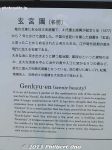
Genkyu-en is a Japanese garden next to Hikone Castle. It was built as a castle garden in 1677 by Ii Naooki, the fourth lord of Hikone Castle. Hakkei-tei Summer House Map
|
|
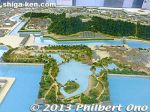
Scale model of Genkyuen Garden next to Hikone Castle at the top of the picture. Garden has a large pond.
|
|
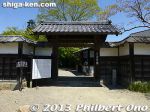
East entrance to Genkyuen Garden. Small admission charged or you can buy a combination ticket with the castle admission.
|
|
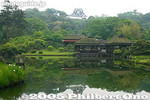
Built as a castle garden in 1677 by Ii Naooki, the fourth lord of Hikone Castle. The garden has representations of the Eight Views of Omi, Chikubushima island, and the Shiraishi rocks in Lake Biwa.
|
|

Hikone Castle overlooks the Hakkeitei teahouses Genkyuen Garden. Hakkeitei was built at around the same time as the garden.
|
|

Genkyuen Garden's tea houses named Hakkei-tei.
|
|
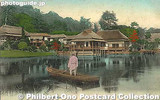
Vintage postcard of Genkyuen Garden. Little has changed except that boats no longer ply on the pond.
|
|
|
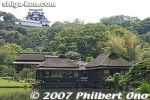
Genkyuen Garden was designed to be enjoyed along a circular walking path.
|
|
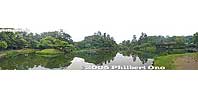
The garden served as the location of one scene in the TV mini-series "Shogun."
|
|
|
|
|
|
|
|
|
|
|
|
|
|
|
|
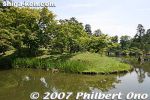
Island in the pond.
|
|
|
|
|
|
|

Genkyuen has miniature versions of Omi Hakkei (Eight Views of Omi). This is one of them, modeled after the Seta Karahashi Bridge in Otsu.
|
|

We cannot cross this bridge.
|
|
|
|
|
|
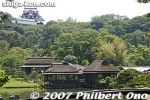
Always scenic to see Hikone Castle overlooking Genkyuen Garden.
|
|
|
|
|
|
|
|
|
|
|
|
|
|
|
|
|
|
|
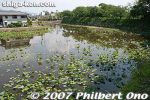
Moat has lotus.
|
|
|
|
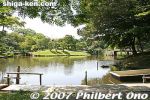
Boat landing.
|
|
|
|
|
|
|
|
|
|
|
|

Tea house on Hosho-dai hill. This was used by the daimyo to entertain guests with good views of the garden. 鳳翔台
|
|
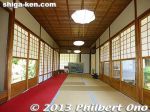
Inside Hosho-dai tea house. They actually serve tea for a fee. 鳳翔台
|
|
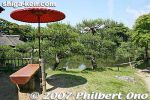
Hosho-dai 鳳翔台
|
|
|
|
|
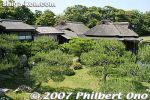
Hakkei-tei
|
|

Hikone Castle
|
|
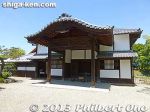
Entrance to Keyaki Goten Palace or Rakuraku-en. Completed in 1679 by the fourth castle lord Ii Naooki as a familiy residence. It took two years to build. It was highly admired for its beauty. 槻御殿
|
|

About Rakurakuen Palace.
|
|
|
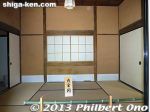
Inside the entrance of Rakurakuen.
|
|
|
|
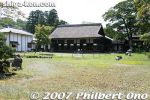
Main building of Rakurakuen.
|
|
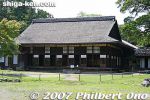
Rakuraku-en or Rakuraku no Ma. In the 1800s, the 12th lord Ii Naoaki built an annex building called Rakuraku-en which faces the garden. 楽々園
|
|

Inside the main room at Rakuraku-en 楽々園
|
|
|
|
|
|
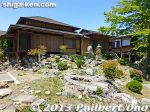
Rakurakuen or Keyali Goten palace has a few other buildings like the Jishin-no-Ma.
|
|

In spring, white herons nest in the high trees of Genkyuen Garden.
|
|
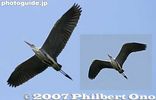
These heron birds make nests in Genkyu-en's trees.
|
|

A heron bringing back a branch to make a nest at Genkyuen Garden in Hikone, Shiga.
|
|
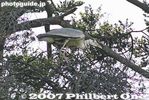
Nesting herons can be quite noisy in spring.
|
|

Genkyuen entrance gate at night in autumn.
|
|

From mid-Nov. to early Dec., the garden is beautifully lit up at night until 9 pm. Note that although the castle tower is also lit up, you cannot enter the castle grounds after 5 pm.
|
|
|
|

Hikone Castle and Genkyu-en fall colors
|
|

Hikone Castle and Genkyu-en Garden in fall
|
|
|
|
|
|
|
|
|
|
|

Ii Naosuke (井伊 直弼) (1815-1860) was the Tokugawa shogunate's Chief Minister (Tairo) who favored and concluded commercial treaties with the Western powers and thus broke Japan's isolation from the world.
|
|
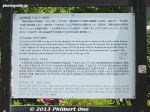
About Lord Ii Naosuke.Naosuke had many enemies who opposed allowing foreigners into Japan or opposed his choice for Shogun Iesada's successor. On a snowy morning on March 24, 1860, Naosuke left his Edo (Tokyo) residence in his palanquin and headed for Edo Castle nearby. Near Sakuradamon Gate, Naosuke was ambushed by 18 anti-foreigner rogue samurai mostly from Mito (Ibaraki Prefecture). It started with a distraction and a bullet hitting Naosuke through his palanquin.
|
|

Postcard of Commodore Perry and Ii Naosuke to mark the 50th anniversary of Yokohama Port's opening in 1909.Naosuke's attackers overwhelmed his unprepared bodyguards within minutes. Wounded and defenseless Naosuke was further stabbed in his palanquin multiple times until he was dragged out by his topknot and beheaded by a Satsuma rogue samurai.
After the assassination, hard feelings continued between Hikone and Mito. But in 1968, the two cities put the past behind them and became friendship cities. Hikone gave white swans from Hikone Castle, and Mito gave plum blossom trees from the famous Kairakuen Garden.
|
|

Near the statue, Hana no Shogai (Flowering Life 花の生涯) monument for Funahashi Seiichi's novel about Naosuke's life that was made into the first NHK Taiga Drama.
|
|
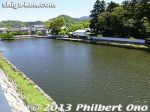
Across the moat from Hikone Castle is Umoregi-no-ya, a reclusive house where Lord Ii Naosuke lived and trained in various arts from age 17 to 32. 埋木舎
|
|

Across the moat from Hikone Castle is Umoregi-no-ya, a house where Lord Ii Naosuke lived and trained in various arts from age 17 to 32. 埋木舎
|
|
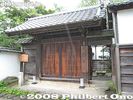
Umoregi-no-ya entrance.
|
|
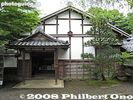
The house has a depressing name. "Umoregi" means petrified wood. Since he was far down the family line to succeed the lordship of his clan, Naosuke did not expect he his life would flower and thereby named this house. 埋木舎
|
|
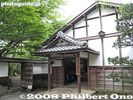
Naosuke bided his time studying and practicing the tea ceremony, flower arrangement, Zen, poetry, martial arts, and other arts.
|
|
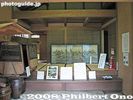
For tea ceremony, he was the one who coined the phrase "Ichigo Ichie," literally meaning one time, one meeting. It can mean, "happens only once." 一期一会
|
|

Palanquin. Did not say that Naosuke rode it.
|
|

Inside a palanquin.
|
|

Inside a palanquin. Seat back cushion.
|
|
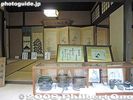
Umoregi-no-ya was restored from 1985 to 1991, costing 200 million yen. Subsidized by the Cultural Affairs Agency, the prefecture, and city. It is a Special National Historic Site.
|
|
|
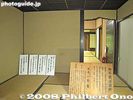
Tea ceremony room
|
|
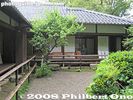
We can peer inside the rooms from outside, but cannot actually enter the building.
|
|
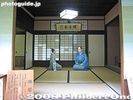
Living quarters
|
|
|

The first NHK Taiga Drama series in 1963 was called "Flowering Life" 花の生涯, based on Naosuke's life here in Umoregi-no-ya. This room shows scenes from that TV series.
|
|
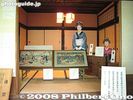
Two maids looked after Naosuke while he lived here.
|
|
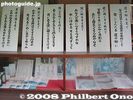
Poems
|
|
|
|
|